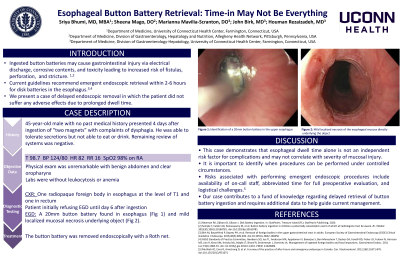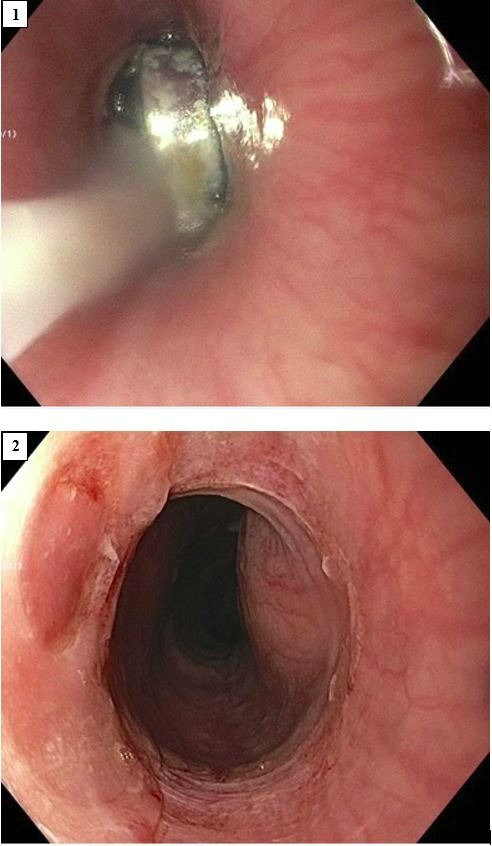Back


Poster Session D - Tuesday Morning
Category: Esophagus
D0232 - Esophageal Button Battery Retrieval: Time-In May Not Be Everything
Tuesday, October 25, 2022
10:00 AM – 12:00 PM ET
Location: Crown Ballroom

Has Audio

Sriya Bhumi, MD, MBA
University of Connecticut Health Center
Farmington, CT
Presenting Author(s)
Sriya Bhumi, MD, MBA1, Sheena Mago, DO2, Marianna G. Mavilia, DO1, John Birk, MD3, Houman Rezaizadeh, MD1
1University of Connecticut Health Center, Farmington, CT; 2Allegheny Health Network, Pittsburgh, PA; 3UConn Health, Farmington, CT
Introduction: Management of ingested foreign bodies is a challenging task given differences in type and presentation. Ingested button batteries cause injury via electrical discharge, corrosive contents, and toxicity. The European Society of Gastrointestinal Endoscopy recommends endoscopic retrieval within 12-24 hours for objects longer than 6 cm. Conservative monitoring can be instituted for blunt objects less than 6 cm in length and 2.5 cm in diameter, or post pyloric. Due to risks of fistulas, perforation, and vocal cord paralysis, ingested button battery cases are handled emergently. However, we present an unusual case that demonstrated significantly delayed endoscopic removal of an ingested button battery without complication.
Case Description/Methods: A 45-year-old male with no medical history presented 4 days after ingestion of ‘two magnets’. He had dysphagia and difficulty eating solid foods, but remaining review of systems was negative. He denied tobacco or alcohol use, and no family history of gastrointestinal cancers. Vitals were normal. His abdomen was benign. Visualization of his oropharynx was unremarkable. Labs did not demonstrate leukocytosis or anemia. Imaging revealed one radiopaque body in the esophagus at T1 level and one in the rectum. Endoscopic removal of the object was delayed until day 6 given patient’s initial refusal. A 20mm button battery was found in the esophagus and removed with a roth net (Fig. 1). Mild localized mucosal necrosis was noted underlying the object (Fig. 2). He tolerated oral intake later that evening.
Discussion: The management of foreign bodies is a challenge due to technical difficulties of endoscopic retrieval and unpredictable outcomes. As seen in this case, the excessive duration of time post button battery ingestion did not correlate to severity and complications expected. Despite its larger diameter of 20 mm, the button battery only caused mild mucosal necrosis. This case demonstrates that esophageal dwell time alone is not an independent risk factor and may not correlate with severity of injury. There are risks associated with performing emergent endoscopic procedures including availability of staff, abbreviated time for full preoperative evaluation, and logistic challenges. It is important to identify when procedures can be performed under controlled circumstances. Our case contributes to the fund of knowledge regarding delayed endoscopic foreign body removal of a button battery but should not be used to guide current management without additional data.

Disclosures:
Sriya Bhumi, MD, MBA1, Sheena Mago, DO2, Marianna G. Mavilia, DO1, John Birk, MD3, Houman Rezaizadeh, MD1. D0232 - Esophageal Button Battery Retrieval: Time-In May Not Be Everything, ACG 2022 Annual Scientific Meeting Abstracts. Charlotte, NC: American College of Gastroenterology.
1University of Connecticut Health Center, Farmington, CT; 2Allegheny Health Network, Pittsburgh, PA; 3UConn Health, Farmington, CT
Introduction: Management of ingested foreign bodies is a challenging task given differences in type and presentation. Ingested button batteries cause injury via electrical discharge, corrosive contents, and toxicity. The European Society of Gastrointestinal Endoscopy recommends endoscopic retrieval within 12-24 hours for objects longer than 6 cm. Conservative monitoring can be instituted for blunt objects less than 6 cm in length and 2.5 cm in diameter, or post pyloric. Due to risks of fistulas, perforation, and vocal cord paralysis, ingested button battery cases are handled emergently. However, we present an unusual case that demonstrated significantly delayed endoscopic removal of an ingested button battery without complication.
Case Description/Methods: A 45-year-old male with no medical history presented 4 days after ingestion of ‘two magnets’. He had dysphagia and difficulty eating solid foods, but remaining review of systems was negative. He denied tobacco or alcohol use, and no family history of gastrointestinal cancers. Vitals were normal. His abdomen was benign. Visualization of his oropharynx was unremarkable. Labs did not demonstrate leukocytosis or anemia. Imaging revealed one radiopaque body in the esophagus at T1 level and one in the rectum. Endoscopic removal of the object was delayed until day 6 given patient’s initial refusal. A 20mm button battery was found in the esophagus and removed with a roth net (Fig. 1). Mild localized mucosal necrosis was noted underlying the object (Fig. 2). He tolerated oral intake later that evening.
Discussion: The management of foreign bodies is a challenge due to technical difficulties of endoscopic retrieval and unpredictable outcomes. As seen in this case, the excessive duration of time post button battery ingestion did not correlate to severity and complications expected. Despite its larger diameter of 20 mm, the button battery only caused mild mucosal necrosis. This case demonstrates that esophageal dwell time alone is not an independent risk factor and may not correlate with severity of injury. There are risks associated with performing emergent endoscopic procedures including availability of staff, abbreviated time for full preoperative evaluation, and logistic challenges. It is important to identify when procedures can be performed under controlled circumstances. Our case contributes to the fund of knowledge regarding delayed endoscopic foreign body removal of a button battery but should not be used to guide current management without additional data.

Figure: Fig. 1 Identification of a 20mm button battery in the upper esophagus
Fig. 2 Mild localized necrosis of the esophageal mucosa directly underlying the object
Fig. 2 Mild localized necrosis of the esophageal mucosa directly underlying the object
Disclosures:
Sriya Bhumi indicated no relevant financial relationships.
Sheena Mago indicated no relevant financial relationships.
Marianna Mavilia indicated no relevant financial relationships.
John Birk indicated no relevant financial relationships.
Houman Rezaizadeh: Alexion Pharmaceuticals – Spouse is employee of, Stock Options, Stock-publicly held company(excluding mutual/index funds). AstraZeneca – Spouse is employee of, Stock Options, Stock-publicly held company(excluding mutual/index funds). Celgene/Bristol-Meyers-Squibb – Grant/Research Support. Regeneron – Speakers Bureau. Skope LLC – Advisory Committee/Board Member, Consultant, Stock-privately held company.
Sriya Bhumi, MD, MBA1, Sheena Mago, DO2, Marianna G. Mavilia, DO1, John Birk, MD3, Houman Rezaizadeh, MD1. D0232 - Esophageal Button Battery Retrieval: Time-In May Not Be Everything, ACG 2022 Annual Scientific Meeting Abstracts. Charlotte, NC: American College of Gastroenterology.
